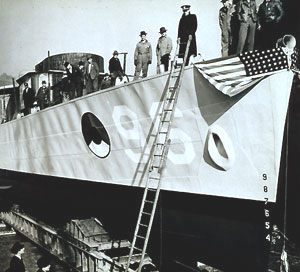
Nashville Bridge Company
Arthur J. Dyer, an 1891 graduate of the Vanderbilt Engineering School, founded the Nashville Bridge Company, the state’s most productive and important bridge building firm. Dyer worked for a variety of bridge companies over in the 1890s before he borrowed $750 and entered a partnership with H. T. Sinnot in a bridge company known as the H. T. Sinnot Company. The firm reorganized in 1902, when Dyer purchased Sinnot’s interest and renamed the firm the Nashville Bridge and Construction Company. In late 1903 or 1904 the firm underwent a second reorganization and became known as the Nashville Bridge Company. The firm built its headquarters in downtown Nashville on the banks of the Cumberland River, where a large complex containing a six-story office building remains. It also maintained a Latin-American branch office in Colombia.
The commissions of Nashville Bridge Company came from throughout the southeastern United States as well as many Central and South American countries. The firm was recognized for its work in movable bridges and built several along the Gulf Coast. The company claimed to have built over half of all the bascule bridges in Florida.
As a result of federal legislation passed in 1916, the bridge building industry changed and standardized bridge plans. While independent bridge companies continued to design and build bridges for cities and counties, their work on state projects was generally limited to providing steel or construction activities.
In 1915 the Nashville Bridge Company built a small floating derrick hull for the Army Corps of Engineers, which marked the beginning of its shift from bridge construction to the marine field. The company expanded by building a new plant in 1922-23 at Bessemer, Alabama. In the late 1920s Dyer’s son Harry took over operations of the firm’s Marine Department. His crews built barges on a production line basis and launched them from pivoted arms, a technique never used before. This new method proved very successful, and the company’s barge business expanded substantially. Although the Great Depression resulted in bankruptcy and closure of innumerable bridge companies across the country, the Nashville Bridge Company’s anomalous survival was due, in large part, to its diversified interests in marine production. In the early 1940s the U.S. Navy hired the firm to manufacture dozens of vessels, and the company expanded its Nashville complex.
Over the years, the Nashville Bridge Company decreased its bridge building and expanded its Marine Department. By the 1960s it had become the world’s largest builder of inland barges. In 1969 the Dyer family sold the company, and there have been several subsequent owners. In 1972 the firm sold its bridge and structural building operations. Although Trinity Marine of Dallas is the current owner, it is still known locally as the Nashville Bridge Company. The company relocated to Ashland City when the city chose its downtown location as the site for Nashville’s Adelphia Stadium. Demolition of most of the complex occurred in 1997, although one of the buildings will be preserved as part of the Shelby Street Bridge pedestrian walkway, scheduled for opening in 2001.



